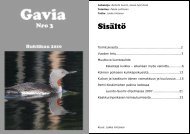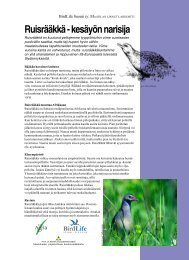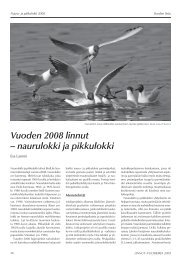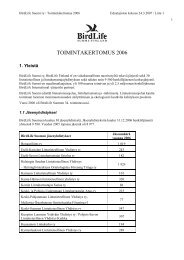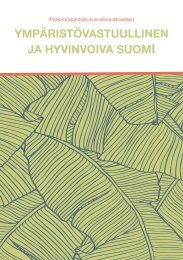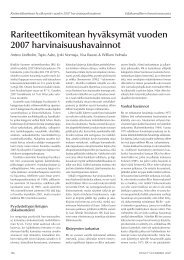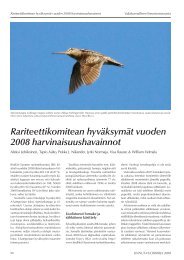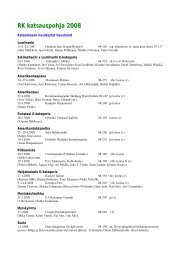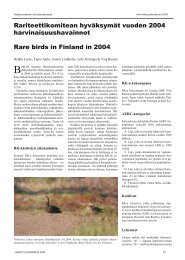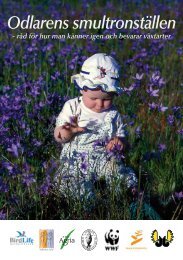LähteetAndrén, H. 1994. Effects of habitat fragmentation onbirds and mammals in landscapes with differentproportions of suitable habitat: a review. Oikos 71,355–366.Biedermann, R. <strong>2000</strong>. Metapopulation dynamics of thefroghopper Neophilaenus albipennis (F., 1798) (Homoptera,Cercodidae) – what is the minimum viablemetapopulation size? Journal of Insect Conservation4, 99–107.Hanski, I. 1994. Patch-occupancy dynamics in fragmentedlandscapes. Trends in Ecology and Evolution 9,131–135.Hanski, I. 1999. Metapopulation ecology. Oxford UniversityPress, Oxford.Hanski, I. <strong>2000</strong>. Extinction debt and species credit inboreal forests: modelling the consequences of differentapproaches to biodiversity conservation. AnnalesZoologici Fennici 37, 271–280.Hanski, I., Lindström, J., Niemelä, J., Pietiäinen, H. jaRanta, E. 1998. Ekologia. WSOY, Porvoo.Hanski, I. and Ovaskainen, O. 2002. Extinction debtat extinction threshold. Conservation Biology 8,666–673.Hanski, I. K., Stevens, P. C., Ihalempiä, P. and Selonen,V. <strong>2000</strong>. Home-range size, movements, and nest-siteuse in the Siberian flying squirrel, Pteromys volans.Journal of Mammalogy 81, 798-809.Hänninen, H. 2001. Luontokohteet ja säästöpuusto talousmetsienhakkuissa – seurantatulokset vuosilta1996–99. Kirjassa: Siitonen, J. (toim.) 2001. Monimuotoinenmetsä. Metsäluonnon monimuotoisuudentutkimusohjelman loppuraportti. Metsäntutkimuslaitoksentiedonantoja 812, 81–95.Kotiranta, H. 2001. The threatened and near threatenedAphyllophorales of Finland. In: Moore, D., Nauta,M.M., Evans, S.E. & Rotheroe, M. (eds). Fungal conservation.Issues and solutions, pp.177–181. BritishMycological Society, Cambridge University Press.Kurki, S., Nikula, A., Helle, P. and Lindén, H. <strong>2000</strong>.Landscape fragmentation and forest composition effectson grouse breeding success in boreal forests.Ecology 81, 1985–1997.Kuusinen, M., Jääskeläinen, K., Kivistö, L., Kokko, A. jaLommi, S. 1995. Indikaattorijäkälien kartoitus Kainuussa.Metsähallituksen luonnonsuojelujulkaisujaSarja A: 39.Kuusinen, M. and Siitonen, J. 1998. Epiphytic lichen diversityin old-growth and managed Picea abies standsin southern Finland. Journal of Vegetation Science9, 283–292.Mönkkönen, M., Huhta, E., Mäkelä, J. ja Rajasärkkä, A.<strong>2000</strong>. Pohjois-Suomen vanhojen metsien linnustoja metsämaiseman muutos. Linnut-vuosikirja 1999,91–97.Ovaskainen, O. and Hanski, I. 2002. Transient dynamicsin metapopulation response to perturbations. TheoreticalPopulation Biology 61, 285–295.Pykälä, J. 2002. Vaateliaat jäkälät häviävät avainbiotoopeilta.Ympäristö 6, 25–26.Pakkala, T., Hanski, I. and Tomppo, E. 2002. Spatial ecologyof the Three-toed Woodpecker in managed forestlandscapes. Silva Fennica 36, 279–288.Penttilä, R., Siitonen, J. and Kuusinen, M. 2002. Polyporediversity in mature managed and old-growth borealPicea abies forests in southern Finland. Manuscript.Rassi, P., Alanen, A., Kanerva, T. ja Mannerkoski, I. (toim.)2001. Suomen lajien uhanalaisuus <strong>2000</strong>. Ympäristöministeriö& Suomen ympäristökeskus, Helsinki.Rosenzweig, M. L. 1995. Species diversity in space andtime. Cambridge University Press, Cambridge.Selonen, V. Hanski, I.K. and Stevens, P.C. 2001. Space useof the Siberian flying squirrel Pteromys volans in fragmentedforest landscapes. Ecography 24, 588-601.Siitonen, J. 2001. Forest management, coarse woody debrisand saproxylic organisms: Fennoscandian boreal forestsas an example. Ecological Bulletins 49, 11–41.Siitonen, J. and Martikainen, P. 1994. Coleoptera and Aradus(Hemiptera) collected from aspen in Finnishand Russian Karelia: notes on rare and threatenedspecies. Scandinavian Journal of Forest Research 9,296–314.Siitonen, J., Penttilä, R., and Kotiranta, H. 2001a. Decayingwood, polyporous fungi and saproxylic insectsin an old-growth spruce forest in Vodlozersky NationalPark, Russian Karelia. Ecological Bulletins 49,231–242.Siitonen, J., Kaila, L., Kuusinen, M., Martikainen, P., Penttilä,R., Punttila, P., ja Rauh, J., 2001b. Vanhojen talousmetsienja luonnonmetsien rakenteen ja lajistonerot Etelä-Suomessa. Kirjassa: Siitonen, J. (toim.)2001. Monimuotoinen metsä. Metsäluonnon monimuotoisuudentutkimusohjelman loppuraportti.Metsäntutkimuslaitoksen tiedonantoja 812.Tibell, L. 1992. Crustose lichens as indicators of forestcontinuity in boreal coniferous forests. Nordic Journalof Botany 12, 427–450.Virkkala, R. ja Rajasärkkä, A. 2001. Luonnonsuojelualueetmetsä- ja suolintukantojen säilyttämisessä. Linnutvuosikirja<strong>2000</strong>, 34–43.Virkkala, R., Korhonen, K.T., Haapanen, R. ja Aapala, K.<strong>2000</strong>. Metsien ja soiden suojelutilanne metsä- ja suokasvillisuusvyöhykkeittäinvaltakunnan metsien 8.inventoinnin perusteella. Suomen Ympäristö 395,Ympäristöministeriö, Helsinki.Väisänen, R. A., Lammi, E. ja Koskimies, P. 1998. Muuttuvapesimälinnusto. Otava, Helsinki.Ympäristöministeriö <strong>2000</strong>. Metsien suojelun tarve Etelä-Suomessa ja Pohjanmaalla. Suomen Ympäristö 437,Ympäristöministeriö, Helsinki.32
Summary: An ecological assessment of the need forforest protection in Finlandby Ilkka HanskiMore than 100 species of animals, plants and fungi have already gone extinct from Finnishforests. The current extinction debt of forest species in Finland is around 1 000 species; thismeans that these 1 000 species will disappear sooner or later unless the area of natural andsemi-natural forests increases significantly.The most important threats to forest species are the low amount of dead wood in managedforests as well as the loss and degradation of the forest types that are naturally most diverse,such as herb-rich forests and old spruce forests. The amount of dead wood in managed forestsis so low, and the key biotopes that are currently preserved in them are so isolated and small,that the threshold values for long-term persistence of most threatened species are not met.To remove the extinction debt and avoid species going extinct requires that the habitat qualityof forests improve above the species’ threshold values. In the case of species dependenton dead wood this implies that the amount of dead wood at the forest stand level should beof the order of 50 m 3 /ha (or somewhat less, 20–30 m 3 /ha, if this were the average for largerareas). The current figure is around 3 m 3 /ha. This target cannot be reached in all commercialforests, so it is sensible to concentrate efforts at increasing amounts of dead wood in smallerareas, including protected areas, where the threshold for threatened species can be reached.However, the current network of protected areas is not sufficient, as only around one percent of forests in South Finland are protected. Less than one per cent of the forests in SouthFinland are currently in a natural or natural-like state. More modest increases in the amountof dead wood in commercial forests will facilitate the occurrence of many non-threatenedspecies.Estimates by biologists suggest that increasing numbers of specialised forest speciesbecome endangered when the area of natural and semi-natural forests falls below 10–20per cent of the forested land. Empirical research results support these predictions. Applyingthe precautionary principle, the target of forest protection should thus be set at 20 per cent,but a target of 10 per cent is acceptable if protected forests and those to be restored arechosen carefully so that they form a functional network of various forest types. Protectionof biodiversity in commercial forests in turn decreases the probability of currently abundantspecies becoming threatened. Such softer methods of forestry in commercial forests therebyhelp attain the overall aims of species conservation.33



